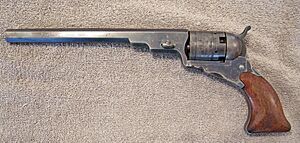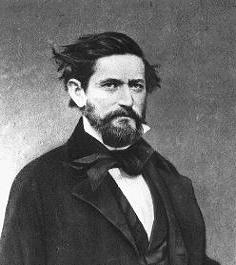Colt Paterson facts for kids
Quick facts for kids Colt Paterson |
|
|---|---|

Colt Holster Model Paterson Revolver No. 5
|
|
| Type | Revolver |
| Place of origin | United States |
| Service history | |
| In service | 1836–1865 |
| Used by | United States Republic of Texas Confederate States of America |
| Wars | Seminole Wars Texas–Indian Wars Mexican–American War American Civil War (later models) |
| Production history | |
| Designer | Samuel Colt |
| Designed | 1836 |
| Manufacturer | Patent Arms Company, Paterson, New Jersey |
| Produced | 1836–1842 |
| No. built | ~2,800 |
| Variants | Different calibers, sizes and configurations |
| Specifications | |
| Mass | 2 lb 12 oz (1.2 kg levered model) |
| Length | 13.75 in (34.9 cm) (Texas model) |
| Barrel length | 7.5 in (19 cm) |
|
|
|
| Caliber | .28 to .36 inch ball, revolver |
| Action | Single-action |
| Muzzle velocity | 900 ft/s (270 m/s) |
| Effective firing range | 65 yd (59 m) |
| Feed system | Five-round cylinder |
| Sights | Blade front sight, hammer notch rear sight |
The Colt Paterson revolver was a very important firearm. It was the first repeating gun sold to the public that used a spinning part called a cylinder. This cylinder held several bullets in separate chambers. These chambers would line up with a single barrel when the gun was ready to fire.
Samuel Colt designed this gun and got a patent for it on February 25, 1836. It was made in Paterson, New Jersey, which is how it got its name. At first, this revolver held five shots and used .28 caliber bullets. A year later, a .36 caliber model was made.
When first designed, the Colt Paterson did not have a special lever to help reload it. Users had to take the gun apart a little bit to put new bullets in. But starting in 1839, a reloading lever was added. This made it much easier to reload without taking the gun apart. Most older Colt Paterson revolvers were also updated with this new feature. Unlike many later revolvers, the Colt Paterson had a special folding trigger. This trigger would only pop out when the hammer was pulled back.
Colt renewed his patent in 1849. He also took legal action against anyone who copied his design. This gave him control over revolver development in the United States until the mid-1850s.
Contents
The Story Behind the Colt Paterson
How Samuel Colt Got His Idea
Early stories from the Colt company say that Samuel Colt got the idea for his revolver in 1830. He was on a ship called the Corvo, sailing from Boston to Calcutta. He supposedly saw how the ship's windlass (a machine for lifting anchors) worked and was inspired.
However, some people think he saw examples of the Collier Flintlock Revolver. This might have happened when he visited the Tower after his ship docked in England. Either way, he made a wooden model of his idea while on the Corvo. He kept working on his design through the early 1830s.
Where the Colt Paterson Was Made
Samuel Colt's first factory was called the Patent Arms Company. It was located in Paterson, New Jersey. Between 1836 and 1842, the factory made many different firearms. They produced 1,450 revolving rifles and carbines, 462 revolving shotguns, and 2,350 revolving pistols.
In 1842, the company ran into financial trouble and closed down. However, a business partner named John Ehlers continued to make and sell about 500 of the pistols until 1847.
Different Types of Paterson Pistols
The revolving pistols held five shots. They came in different sizes, from "pocket" models to "belt" and "holster" models. These names described how they were meant to be carried. The bullet sizes ranged from .28 to .36 inches. The most famous model is the Number 5 Holster or Texas Paterson. About 1,000 of these were made, and they used .36 caliber bullets.
How the Colt Paterson Worked
Using the Single-Action Design
The early Colt revolvers were "single-action" guns. This means you had to pull the hammer back by hand before each shot. Pulling the hammer back also made the folding trigger appear. The gun had many small parts and springs, which made it seem more like a fancy clock than a tough tool for outdoor use. Black powder residue from firing could also cause problems.
Loading the Early Models
The first Paterson models (made from 1836 to 1838) were tricky to load. You had to take them apart a bit. Also, there was no easy way to carry the gun safely with all chambers loaded.
To load one of these early revolvers, you would:
- Pull the hammer back to half-cock. This allowed the cylinder to be removed and turned.
- Push a small metal piece called the barrel wedge from right to left.
- Pull off the barrel, then the cylinder, from the main rod.
- Fill each chamber with gunpowder, leaving space for a lead ball.
- Use a special tool to push the lead balls firmly into place.
- Put the barrel, cylinder, and wedge back on.
- With the hammer still at half-cock, place percussion caps on each tube using a special tool.
These revolvers often came with extra cylinders. People would load and cap these spare cylinders ahead of time for quick reloading. This was common, even though it was risky. If the caps were hit or the cylinder dropped, the gun could fire by accident.
Safer Ways to Carry and Reload
People found different ways to carry the gun more safely. Some would leave the hammer at half-cock. Others would lower the hammer onto a loaded chamber, which was very dangerous. Some would load only four chambers, leaving an empty one under the hammer. Later Colt revolvers had a special notch on the hammer. This notch would fit over a safety pin between the chambers. This kept the hammer from touching the caps until the gun was ready to fire.
In 1839, a hinged loading lever and a capping window were added to new revolvers. Older designs were also updated with these features. This meant the revolvers could be loaded without taking them apart. When these improved Paterson revolvers reached Texas in 1842, Texas Ranger Captain John Coffee Hays was very happy. His Rangers could now reload their guns while riding horses.
How the Colt Paterson Performed
Firing the Revolver
To fire the Paterson, you would pull the hammer back with your thumb. This action would spin a chamber into line with the barrel and lock the cylinder. It also made the folding trigger drop down into position. You would aim using a small blade at the front and a notch on the hammer. You would repeat these steps for each of the five shots. For safety, many people would only load four shots. They would leave the hammer resting on an empty chamber for normal carrying.
Accuracy and Power
Compared to later Colt revolvers, the Paterson had some design flaws. But even with its unique grip and trigger, it aimed pretty well and was accurate enough. Samuel Colt wanted the gun to be accurate. This is clear because it had a rifled barrel (grooves inside the barrel that make the bullet spin). Some sets even came with extra-long barrels.
If you use modern copies of the gun, you can expect good accuracy. Careful, one-handed shooting can hit targets within 2 to 3 inches at 60 feet. The Number 5 Belt Revolver could be effective up to 50 yards in perfect conditions. But from a moving horse, it would only be useful at very close range.
The power of the Paterson is similar to a modern .380 pistol. The round ball it fired weighed about the same, and the speed of the bullet was also similar. The cylinder was a bit shorter than later Colt revolvers. But it could still hold enough black powder for a good shot.
| Gunpowder | Velocity | Deviation |
|---|---|---|
| 22 grains (1.4 g) Goex Brand FFFg | 879 feet per second (268 m/s) | 37 ft/s (11 m/s) extreme spread |
| 90-year-old FFFg from cartridges | 943 feet per second (287 m/s) | 75 ft/s (23 m/s) extreme spread |
Military Use of the Colt Paterson
Colt sold the Paterson revolver and carbine (a shorter rifle) to the United States Army. They were used a little bit in the Second Seminole War in Florida. Soldiers at first liked the extra firepower they offered. However, the U.S. government thought the guns were too fragile and broke down too often.
The Republic of Texas bought 180 revolving shotguns and rifles. They also bought the same number of handguns for the Texas Navy in 1839.
When Samuel Houston ended the Texas Navy in 1843, Captain Jack Hays gave his company of Texas Rangers the extra pistols. The repeating handguns became very popular with the Rangers. They gave them a big advantage in fights against their Comanche enemies.
The Paterson revolver was especially important in the Battle of Bandera Pass. Each Ranger had 10 shots if they carried two pistols. This was much more than the one shot they would normally have. Captains Jack Hays and Samuel Walker of the Texas Rangers really liked Colt revolvers. They helped get military contracts for later models, like the Walker Colt.
Zachary Taylor, who was a general in charge of the border with Mexico, sent Captain Walker to New York in 1846. Walker met with Colt to talk about ways to make the Paterson better for battle. At this time, Walker was serving in the U.S. Mounted Rifles, not the Rangers.
Images for kids









